
December 13, 2024 – How could you not have an enjoyable time at the serene 75-acre 1440 Multiversity Campus in Scotts Valley, a purposeful learning destination where energy, discovery and creativity flourish?
Amidst redwoods, lit by the last flashes of autumn’s deciduous trees, the setting is so Zen, you feel the tethers of the world letting go of you as you exhale.
I wasn’t sure what to expect when I arrived to attend the first sessions of a Teaching Kitchen Weekend that lasted three days and two nights and included everything from cocktails and charcuterie on Friday night, to wellness classes and hands-on culinary workshops on Saturday, followed by a sommelier led wine pairing dinner with Ryan Fillhardt of The Village Pub in Woodside.
On Sunday, workshops featured tablescapes and menu writing, accompanied by 1440’s signature movement, art and meditation classes.
Arriving on Saturday morning, I was encouraged by the helpful front desk staff to head to Common Grounds, the campus coffee shop, where I picked up a decaf latte, then meandered through the gardens and the fire pits, inhaling the beauty of the early morning sun on the abundant flora. Almost in a reverie, I walked up to the teaching kitchen, along with my fellow students, where we were greeted by the exuberant staff. The front counter was laden with a colorful seasonal produce display, and the rollup doors of the kitchen opened onto the garden. At each well-appointed two-person station, were cutting boards, knives, cooking utensils, measuring spoons, aprons and a set of ingredients for the first two dishes we were about to make. Bowls, towels, etc. were on racks beneath the work surface.
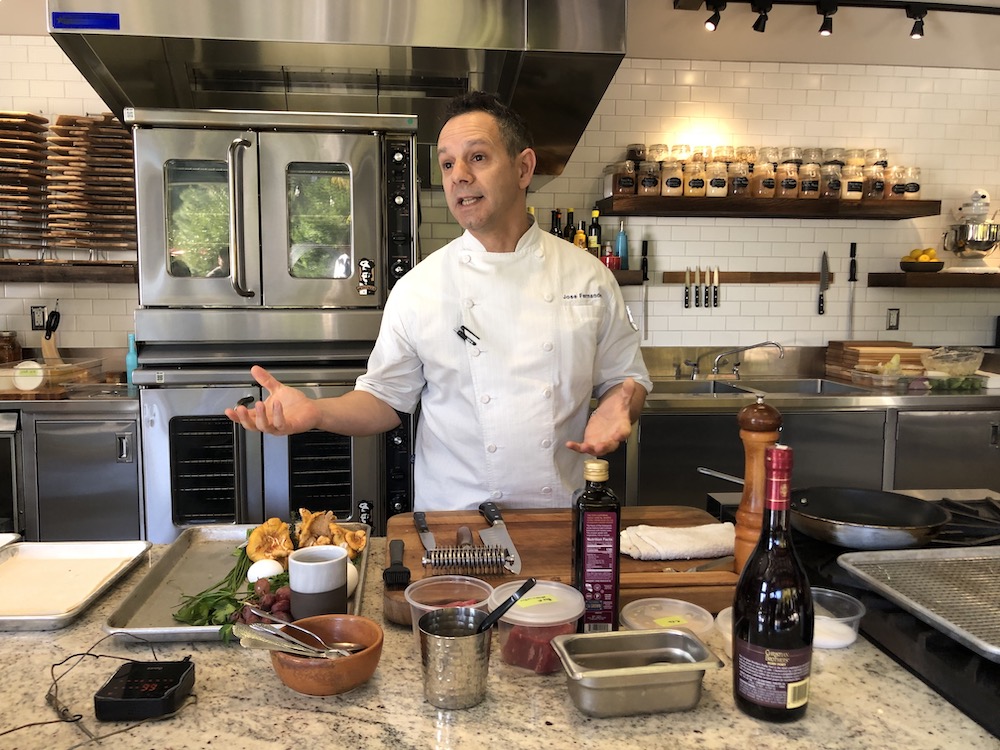
Executive chef Jose Fernandez and executive sous chef Arturo Salazar of the 1440 culinary team, both gracious, warm and as affable as sunshine on your pillow, welcomed us to the program, which had been on hiatus since the pandemic. Salazar, who would lead the first session, explained he had been cooking in the Monterey Bay area for many years since graduating from Humboldt State, working at the Pebble Beach Company, Sierra Mar restaurant and at Salinas Valley Memorial Hospital, where he says he truly fell in love with the concept of food as medicine.
“Giving people a choice of food, immediately changed their outlook,” he said, although he admitted that diet restrictions tended to make meals a bit too bland for his taste. Here at 1440 he is thrilled to have the chance to take healthful food to the next level.
To that end, he informed us that we’d first be making a shaved Brussels sprouts salad (using beautiful Brussels from Lakeside Organic Gardens in Watsonville) with black garbanzo beans (from Rancho Gordo), endive, red onion, pine nuts, Kalamata olives, cranberries and Kabosu vinaigrette, followed by butternut squash gnocchi with brown butter sage sauce and lastly Beef Wellington.
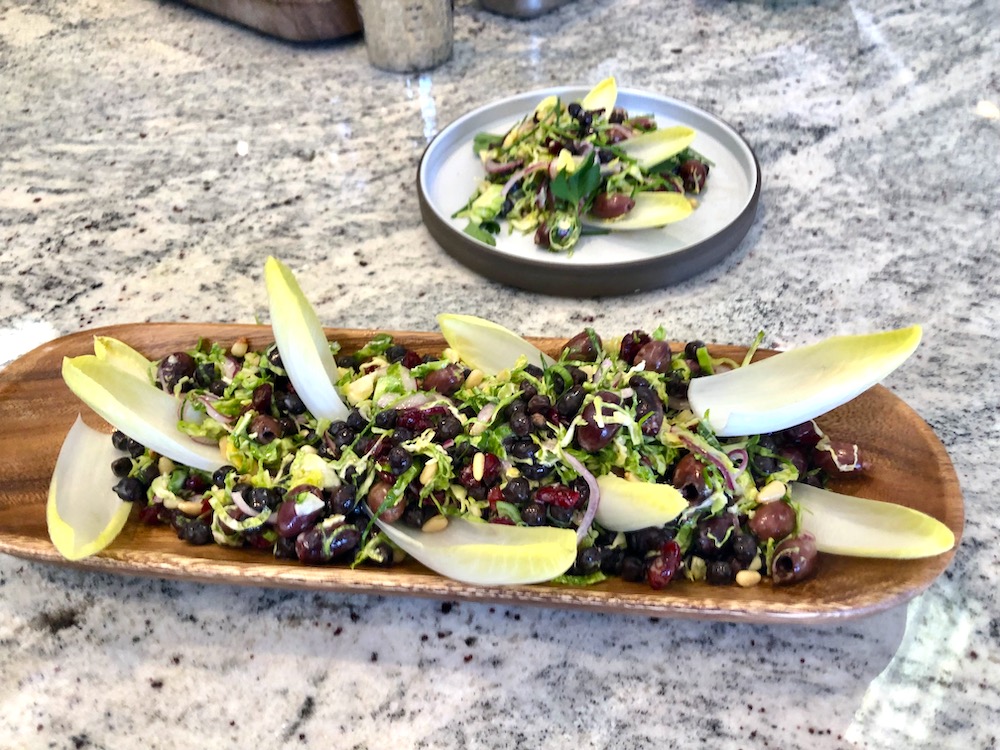
Say, what now? I wasn’t prepared for such an ambitious agenda, but my classmates were great company and soon everyone was watching as chef Salazar showed us how to properly hold and use a chef’s knife.
“I didn’t want to take the chance of having you use a mandolin!” he explained. He suggested gripping the knife like a sword, and not putting your forefinger on the top of the blade, which can tire your wrist out more quickly. Salazar instructed us to first peel off all the dark outer leaves of the sprouts, then cutting them in half through the stem. You grab the sprout with four fingers atop to steady it, “make your fingers like a bear claw,” Salazar suggested, cutting from the top of its head to just before the stem, which you then discard.
After shaving, the sprouts were then doused with apple cider vineyard, olive oil and a bit of salt. This begins the process of breaking down the shredded vegetables.
Taking the red onion next, Salazar explained that understanding fiber direction was key to slicing the onion, which would be served raw, against the grain, so it would break down more quickly. He noted that if we wanted to, we could put the slices into an ice water bath, which would pull out the juices, leaving the sweeter flesh. It would also keep them crunchier. With all the ingredients that went into this salad, including the Yuzu-based Kabosu vinaigrette, it ended up being pretty flavorful, although I wanted more of a lemon flavor. Salazar suggested using the whole endive spears as a utensil for eating the salad. It does make an impressive presentation.
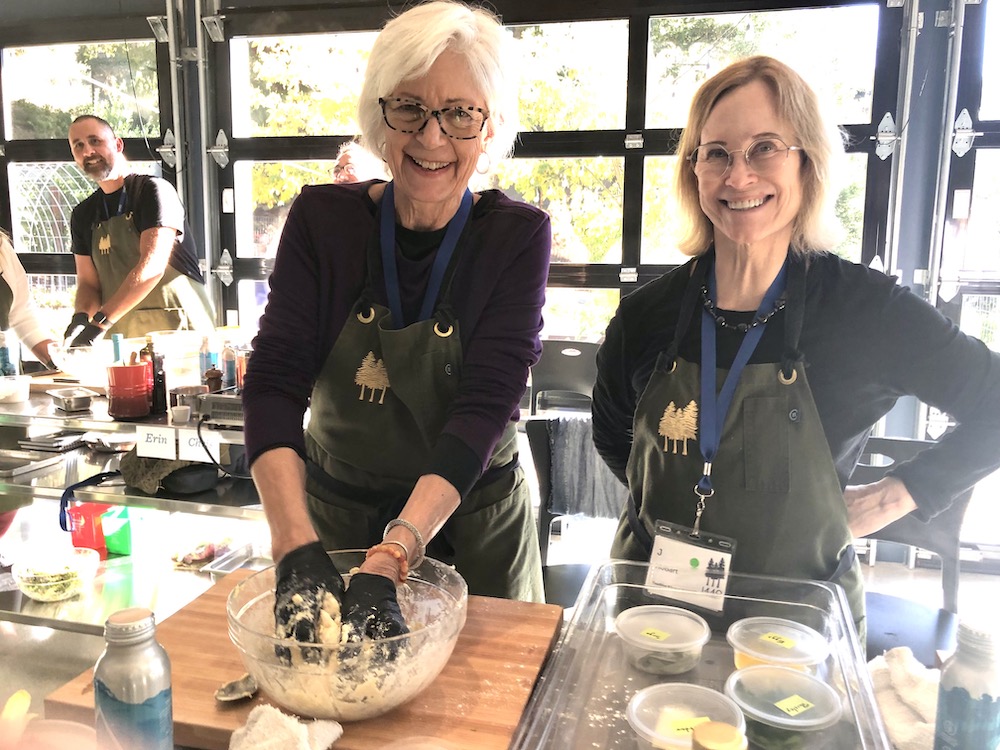
Then it was time for flour power, as we dove into making gnocchi. Into a bowl went an egg, olive oil, about ½ cup of butternut squash puree, and a cup of ricotta, which were all mixed together before adding a cup of parmesan cheese. Then it was time to add the flour, about one cup total, until the dough formed and could be formed into a ball, then rolled out into tubes about ½ inch thick. Salazar cut his gnocchi into 1” pieces and used his thumb to imprint them. My table used fork tines for the heck of it, which proved the pinnacle of our artistic creativity. The Beef Wellington crust was another story.
It was my job to overcook the gnocchi, sadly, and then sauté them in butter with sage leaves. I’ll just say to keep the olive oil handy and keep the heat at 180° to avoid getting things too crispy. One of the pro chefs in the class, Terry Braggs, who teaches cooking at Stanford to students and faculty told me later that you absolutely must take the gnocchi out of the water as soon as they float. His were pillowy and amazing, while ours frankly tasted like Parmesan Cheezits.
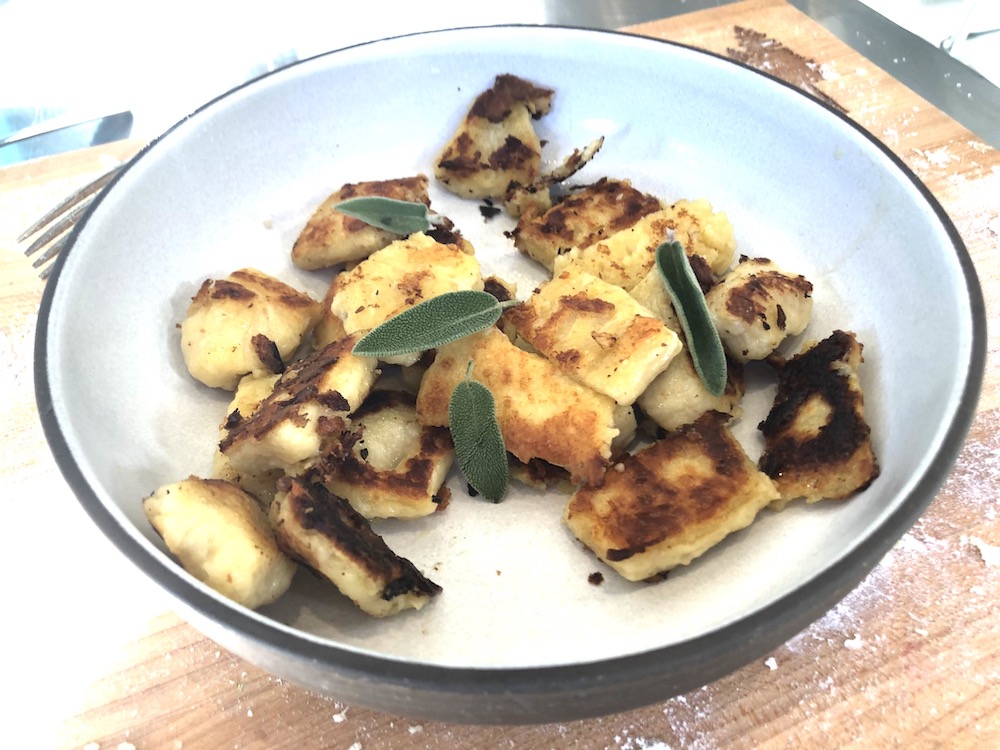
While we were making a mockery of gnocchi at our table, chef Salazar prepared some outstanding potato latkes using peeled russets. The grated potatoes went into ice water to prevent browning, then were tossed with two eggs and about a half cup of cornstarch per 2 pounds of potato, plus ½ cup chopped green onion. He quickly fried them on both sides and topped them with crème fraiche and some caviar. Needless to say, at this point, nobody was going to be very hungry for lunch.
Chef Fernandez, who hails from Lisbon and has a wry sense of humor, returned to lead the assembly of Beef Wellington. Alongside the containers holding the beef, a cup with port and a tray with a sheet of pastry, there was a pile of gorgeous chanterelles, shallots, parsley, thyme, garlic and grapes.
“You’ll notice that all the ingredients are assembled for you and ready to go. What do we call this? There’s a French term.” He waited for the group to answer him, but our collective brain apparently failed the search. It turned out to be “mis en place,” a critical philosophy when cooking, especially a dish that has as many parts as a typical box of Ikea furniture.
“Failing to prepare is preparing to fail,” said Fernandez, quoting one of his early culinary mentors. I’ll try to remember that one. He instructed us to cut the puff pastry sheet in half.
Chef Salazar came around to show us how to properly brown the tenderloin in olive oil on all sides, seasoning it with pepper and a bit of salt, tossing sticks of thyme into the pan for additional flavor. After the meat was sufficiently seared, it went onto a small rack to rest while we tore the chanterelles into strips and cooked them in the remaining olive oil in the meat pan, adding shallots, grapes, and then after a few minutes, the garlic, so it did not burn, and finally some chopped parsley. We made sure the chanterelles had plenty of port to absorb as they cooked with the other ingredients until the grapes were softened.
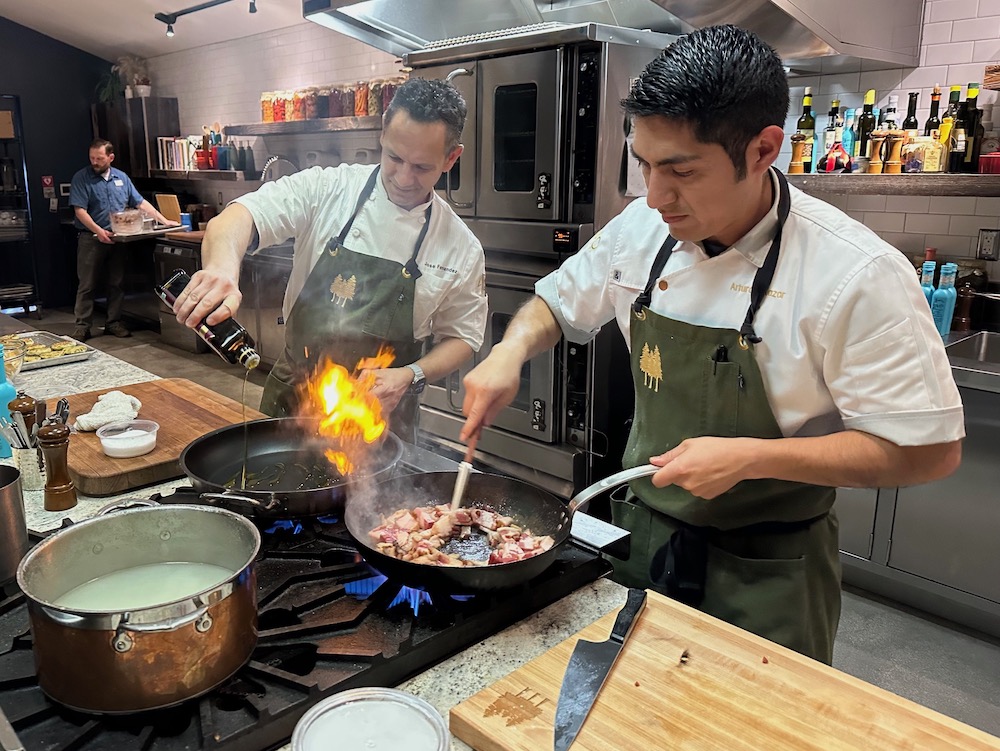
Then it was time to cut the meat not quite in half with a sharp knife, leaving a side intact. We filled the pocket with the shallot-chanterelle mixture, then wrapped the stuffed tenderloin with one of the two halves of puff pastry, folding the edges underneath. This is where things got tricky, and the inevitable separation of those with true talent from those who don’t, became most obvious. We might not have used quite enough pressure when using the pastry torture device, which lays down parallel tracks in the dough like a snow-grooming machine. Our attempt to separate the lines to create diamond shapes, which is the desired outcome, resulted in what looked more like a kelp forest at the Monterey Bay Aquarium.
We did the best we could, but compared to the final results of the other teams, ours was pretty laughable, even after bathing it with an egg wash. I was amazed at the prowess displayed by the rest of the group, which included two women who had flown in from Houston. Chefs Salazar and Fernandez then placed the racks of dough-covered meat into the oven and then set the thermometer to 135. Fernandez explained that having an e-thermometer is so worth it, as you know exactly when to pull your dish out of the oven, as the meat will continue to cook for ten minutes after reaching the desired temperature. Someone asked if it should be tented with foil, to which he answered, absolutely not.
“If you are cooking a roast and you want it to get to 135 eventually, you pull it out at 130, then tent until it gets to 135, which will be medium rare,” said Fernandez. “Always take it out 5 degrees before the done-ness you want. In the case of chicken, which you want to get to 165 to kill bacteria, you pull it at 160, so it retains the moisture.”
Salazar was then asked whether to use butter or olive oil when cooking eggs. He says he always uses both, and when cooking an omelet or scrambled eggs, cuts the butter into little bits and drops it on top of the egg mixture to add more of that buttery flavor.
Sadly, I had to run to another event, as the great questions kept coming. I trust that our kelp-covered Beef Wellington turned out swimmingly.
1440 Multiversity plans to hold Teaching Kitchen Weekends on a regular basis throughout 2025 and add more learning lunches and dinners that will be open to the public.
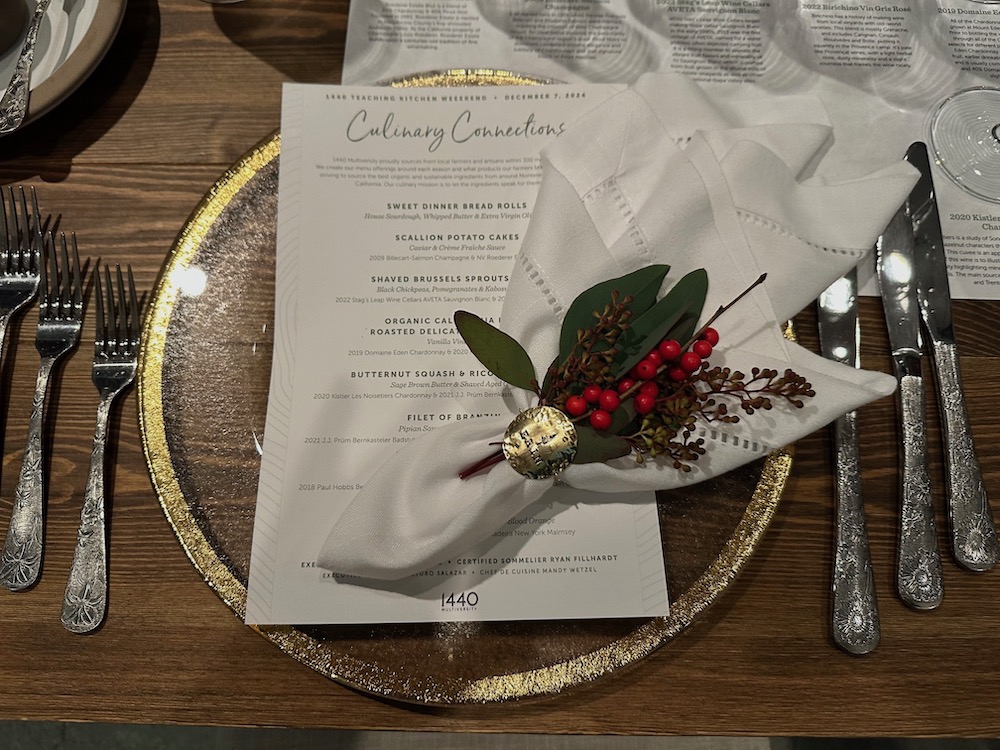
About the author
Laura Ness is a longtime wine journalist, columnist and judge who contributes regularly to Edible Monterey Bay, Spirited, WineOh.Tv, Los Gatos Magazine and Wine Industry Network, and a variety of consumer publications. Her passion is telling stories about the intriguing characters who inhabit the fascinating world of wine and food.
- Laura Nesshttps://www.ediblemontereybay.com/author/lness/
- Laura Nesshttps://www.ediblemontereybay.com/author/lness/
- Laura Nesshttps://www.ediblemontereybay.com/author/lness/
- Laura Nesshttps://www.ediblemontereybay.com/author/lness/


